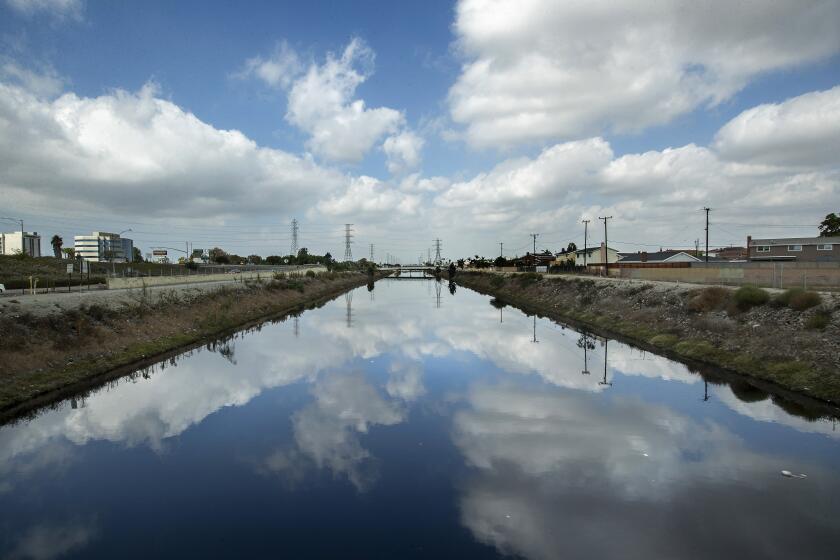‘Stinky City’: Anger grows in Carson as noxious smell sickens residents, eludes solution
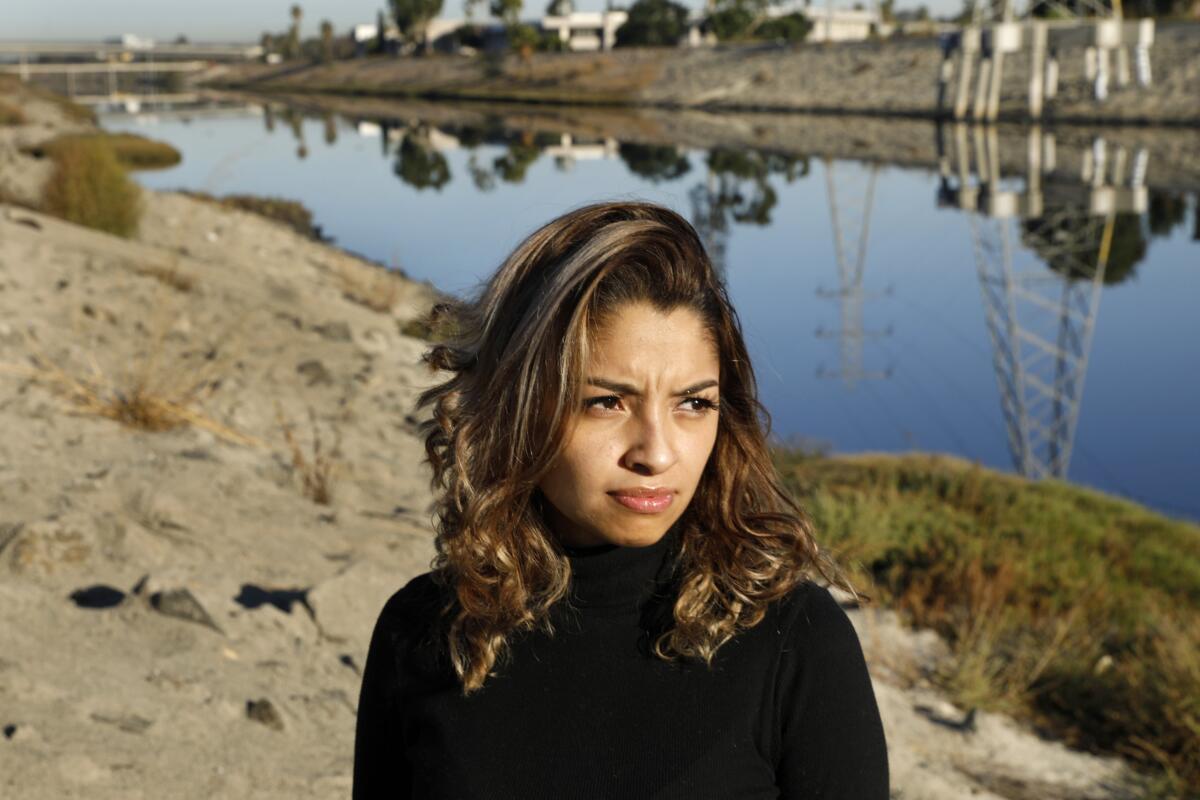
- Share via
When Otilia Marquez drives through Carson with her mom and little sister, the air stinks so much that one of them always jokes: “Who farted? Who didn’t take a shower? Put your shoes back on!”
One afternoon, Marquez’s sister whipped out a can of Febreze, stuck it out the open car window and gave a spray. At home, Marquez has been burning black-cherry-scented candles, trying in vain to beat back the stench.
“It’s like we’re gonna be known as that stinky city now, and I don’t want that,” said Marquez, 27, who has lived in Carson her entire life.
For nearly two weeks, an overpowering foul smell — likened to rotten eggs, a dead body and poop — has been wafting from the Dominguez Channel, which spills into Los Angeles Harbor.
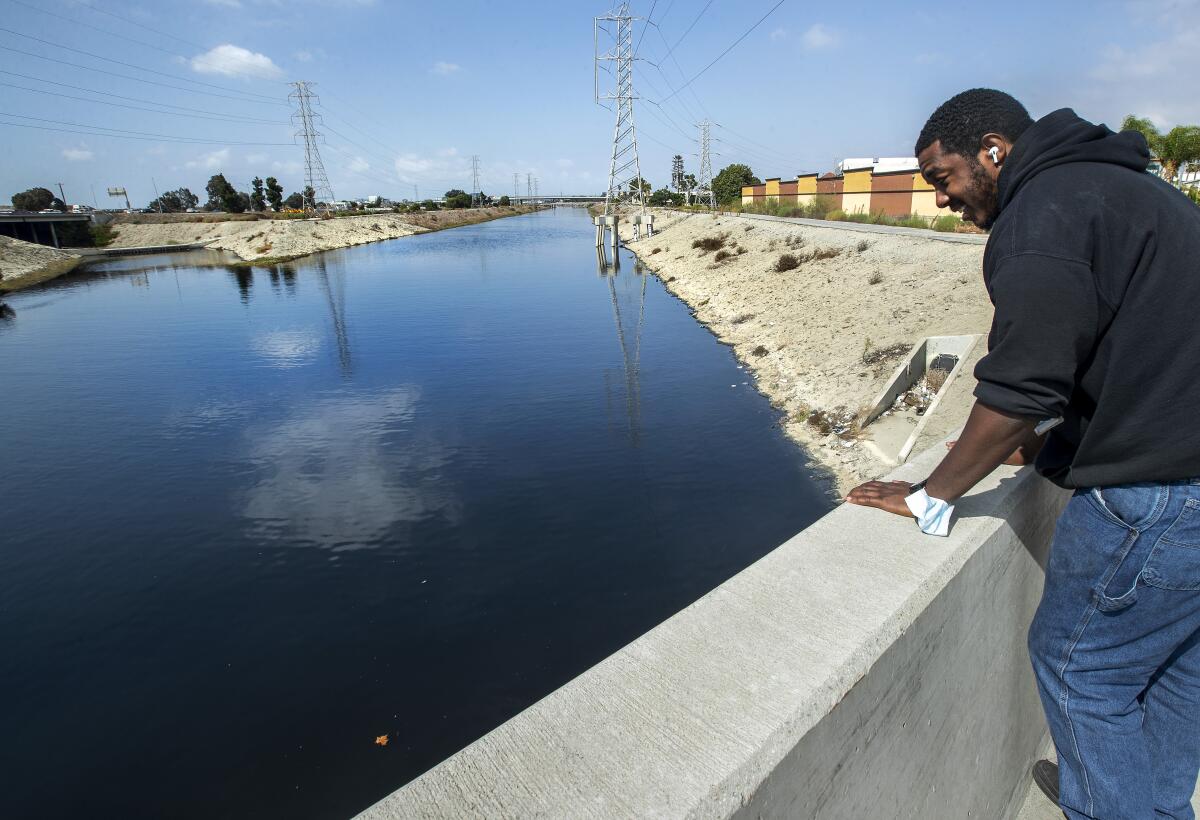
The stink has been the butt of plenty of online jokes: “If you can’t smell the air in Carson you DEFINITELY have COVID,” one Twitter user quipped. Others have suggested filling the Goodyear Blimp, which has a base in the city, with Febreze, or a water-dropping helicopter with Lysol.
Outside City Hall, a protester this week held a sign reading: “What the funk?”
Even as residents like Marquez, who has had headaches and burning eyes, try to keep a sense of humor, they are outraged by the odor and the slow response by government officials.
Los Angeles County officials say the smell is caused by hydrogen sulfide — a flammable, colorless gas known as “sewer gas” — coming from decaying vegetation in the channel that has built up because of the drought.
It took nearly two weeks for county crews to begin spraying with a biodegradable odor neutralizer called Epoleon that will convert the hydrogen sulfide to a salt.
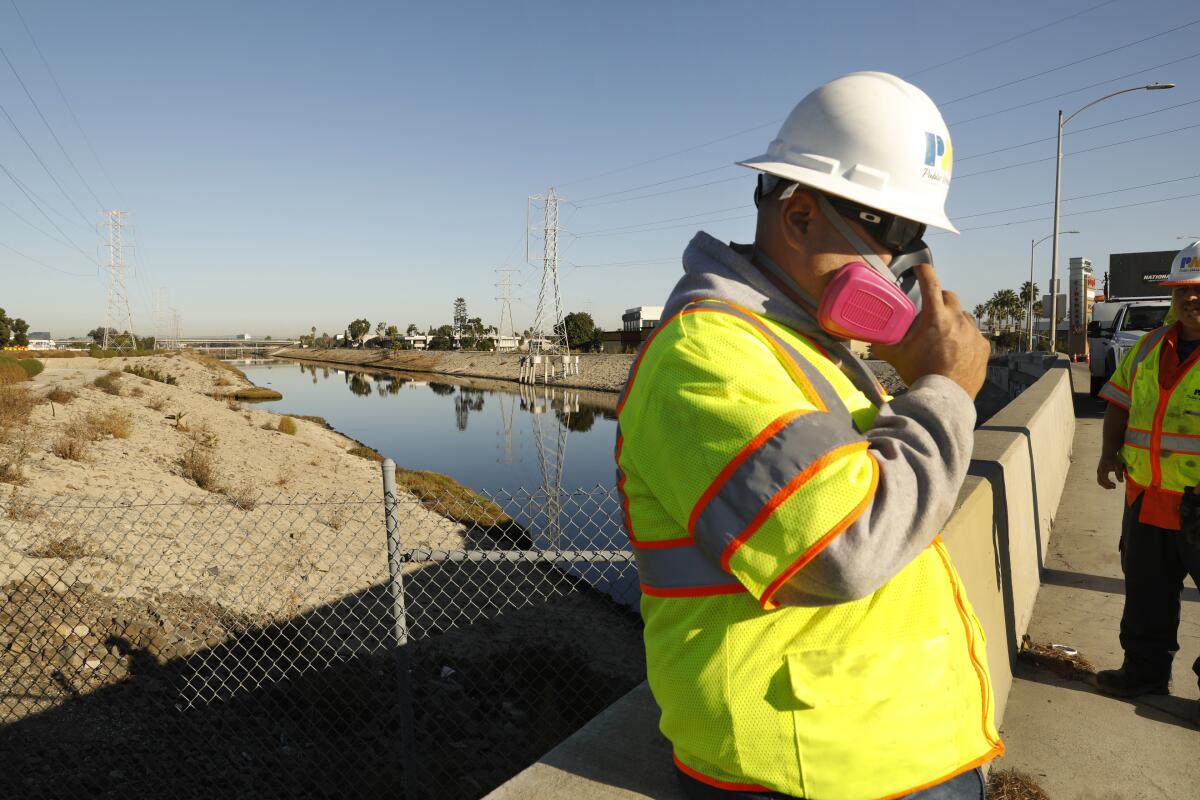
The spraying began Friday, and workers will soon pump oxygen into the water, since hydrogen sulfide is produced in unoxygenated environments.
The odor is expected to dissipate within five days, said L.A. County Public Works Director Mark Pestrella.
County and city officials say they had to wait for investigators and scientists to determine the cause of the odor before they could act.
But questions remain over whether communication breakdowns among different agencies led to the delay.
The smell was first reported Oct. 3 to the South Coast Air Quality Management District, which has now received more than 2,000 complaints.
But air quality officials did not notify the L.A. County Department of Public Works, which manages the channel, until Oct. 7, said Kerjon Lee, a department spokesman.
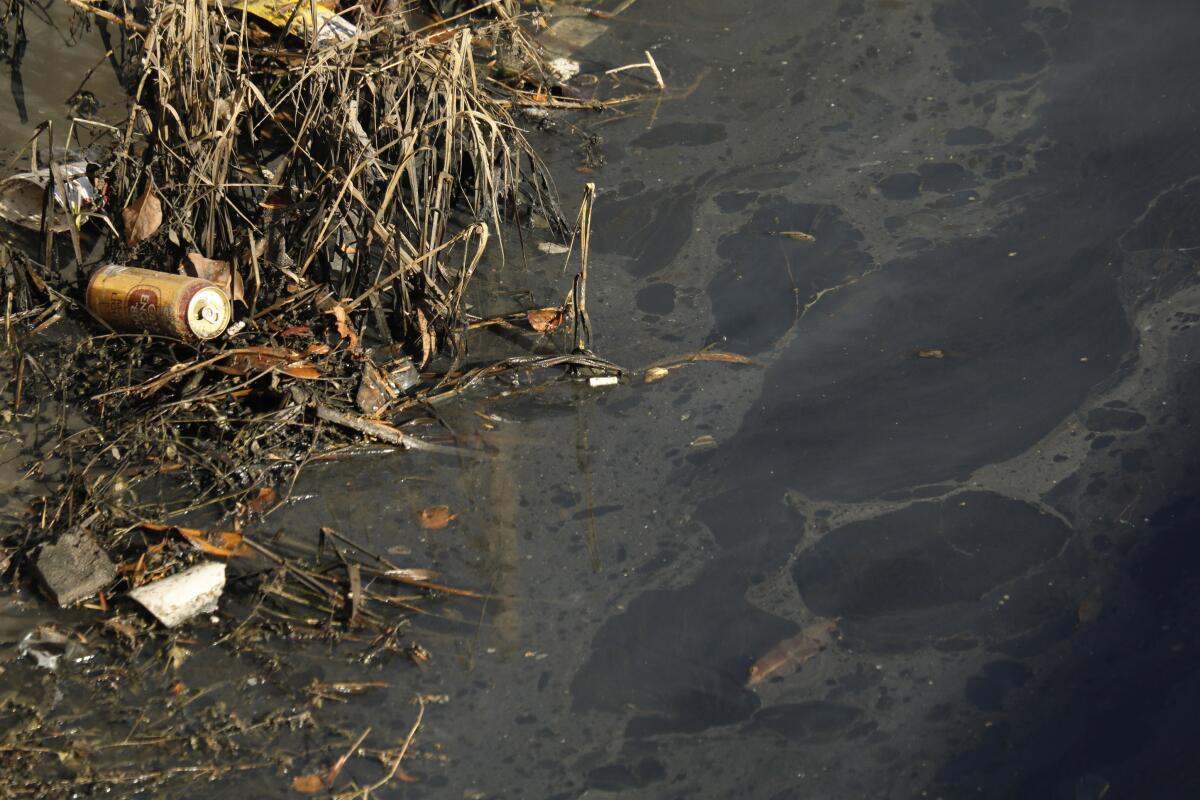
Public works crews began inspecting the channel that day, Lee said.
By that Friday, the onsite investigation included L.A. County hazmat, sanitation and public works, the South Coast air quality district and petroleum industry officials.
One petroleum industry investigator was overcome by the smell and became lightheaded, Lee said.
The Carson City Council did not declare the smell a public nuisance until Oct. 11 — eight days after it was officially reported.
The noxious fumes can cause headaches and nausea, but officials say the levels in the air are too low to cause long-term health effects.
Elevated levels of hydrogen sulfide were confirmed Sunday evening in Carson, which led some residents to experience nausea, headaches, and eye, nose or throat irritation.
Earlier this week, county officials announced that residents can be reimbursed for air purifiers and hotels.
The city followed with its own reimbursement program, which will also include medical expenses and will come out of $100,000 in emergency funds.
But people have already been suffering from the odor, and it could take weeks to get the reimbursements.
Birds could also be at risk because they eat bugs that may have ingested toxic substances.
“We are behind, and I think as a city government we should just admit our mistake,” Carson Mayor Pro Tem Jim Dear said during a special meeting Thursday night. “We should have acted immediately.”

The highest levels of hydrogen sulfide in the air have been detected near the channel’s intersection with Avalon Boulevard near the 405 Freeway, officials said. A nearby shopping district includes the South Bay Pavilion and an Ikea.
This section of the channel is a protected estuary with natural vegetation and wildlife, officials said. Saltwater from the harbor mixes with fresh water and urban runoff.
On an afternoon this week, water in the channel sparkled in the sun, and there were no visible clusters of vegetation. But garbage — including plastic bottles, food wrappers and disposable masks — could be seen in the water in places.
In a normal year, storm water would have washed away more of the underwater vegetation. This year, the drought caused additional buildup.
Beneath the surface, the vegetation was decaying — and the process may have been sped up by pallets and cardboard dumped upstream, which provided food for the bacteria, according to the public works department.
County agencies are investigating whether a fire at a pallet yard led to the dumping.
Hydrogen sulfide is produced by decaying organic matter such as dead animals or dying plants.
Humans can detect the smell at very low levels, which helps us notice when food is rotten, said Barbara Belmont, a chemistry lecturer at Cal State Dominguez Hills in Carson.
Belmont compared the Dominguez Channel to a human intestine and the hydrogen sulfide to flatulence.
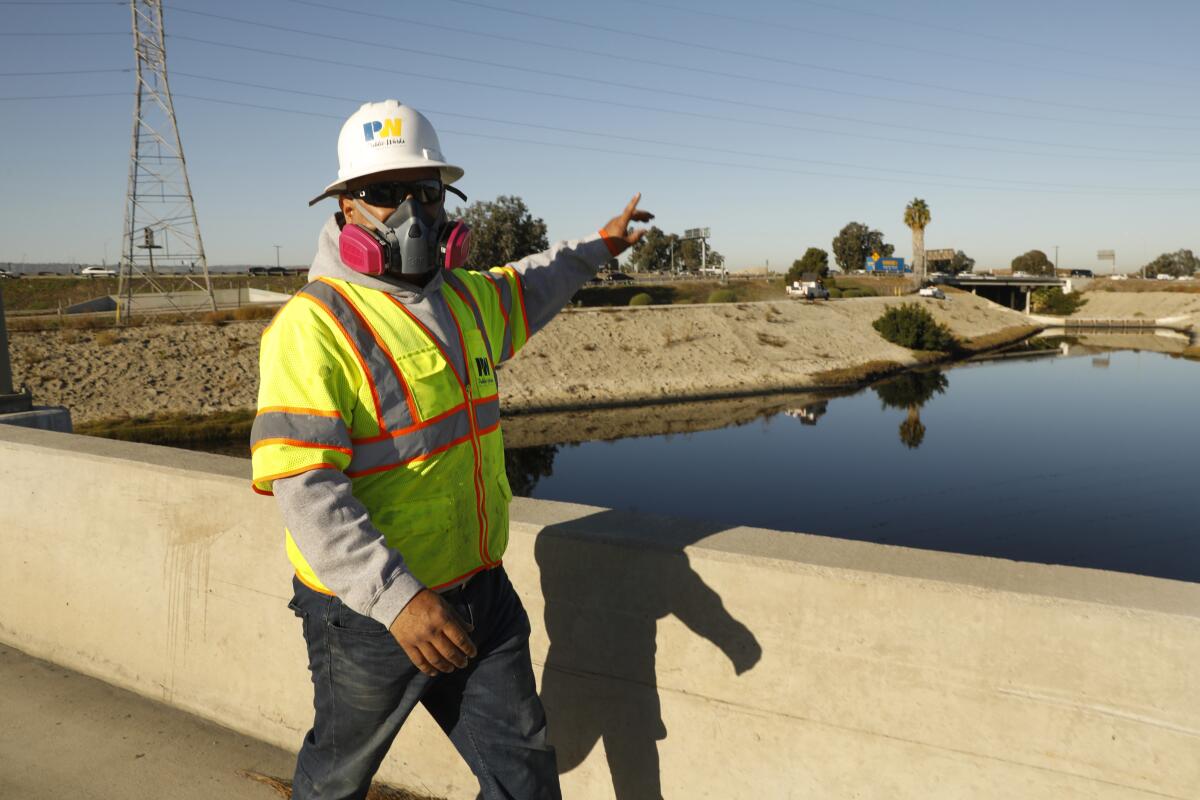
“Normally, when things in the channel are flowing properly, and there’s plenty of oxygen, and the water is moving, the good bacteria are thriving,” she said. “Most of the time, there’s good bacteria, and the emissions are generally odorless.”
But now, bacteria that thrive without oxygen are flourishing in the slower-flowing water, and their hydrogen sulfide emissions stink, as when people pass smelly gas after eating something foul, she said.
The levels of hydrogen sulfide measured in the area are “well below what’s actually hazardous and what would lead to an emergency where everyone needs to get out,” Dr. Muntu Davis, the county’s health officer, said in an interview.
If people have persistent, worrisome symptoms, they should leave the area until the smell is gone, Davis said.
But with the current hydrogen sulfide levels, he is not worried about long-term health effects.
Many residents are not reassured.
“How can anyone say it’s safe?” asked Stephanie De La Rosa, 52, who lives half a mile from the Dominguez Channel. “People are getting sick, and it’s difficult to breathe.”
De La Rosa, who initially thought the smell was coming from nearby refineries, has had headaches and a sore throat. Her 21-year-old daughter, Samantha De La Rosa, who is five months pregnant, has also had headaches, along with itchy eyes.
“It’s already affecting me now,” Samantha De La Rosa said. “How will I know it won’t affect my baby?”
Carson City Councilman Jawane Hilton said in an interview that the city decided to offer money to residents because many could not afford to pay for hotel rooms and air purifiers while waiting to be reimbursed by the county.
Carson is 37% Latino, 27% Asian, 24% Black and 7% white.
Hilton, who is Black, said the smell is the latest example of communities of color being more exposed to pollution.
Several refineries operate in or near Carson, which many people initially thought were the source of the smell, he said.
Hilton, who cited the county’s response to a massive sewage discharge at the Hyperion Water Reclamation Plant in upscale Playa del Rey this summer, said it’s unacceptable that the people of Carson have been living with the smell for weeks.
“People believe that if they were in a different area, if this was Beverly Hills or Manhattan Beach or Hermosa Beach, that aid would have already come, but that they’re blowing it over for our community,” Hilton said. “We’re told, ‘It’s just a little gas, don’t worry about it.’”
Hilton said he has had severe headaches at City Hall in recent days, and he is not allowing his three young children to play outside.
Beverly Jackson has resumed wearing a mask outdoors when she power-walks at a local park.
She likened the odor to “old diapers” and has had watery eyes and mild headaches at times.
“Let’s be real. The city failed us,” Jackson, 72, a retired accountant, said Friday. “This has been going on for almost two weeks, and where are the solutions?”
Jackson, who is Black, questioned whether it would have taken so long to fix the problem if it had happened in Beverly Hills, Malibu or Culver City, all of which are mostly white.
She said she would probably purchase an air filter and claim reimbursement from the county. She has air conditioning, but she worries about her neighbors who don’t and wishes the hotel reimbursement had been offered sooner.
Though Marquez jokes about the stench and her ever-present Febreze, the situation has been miserable, she said.
She lives with her parents and teenage sister near a refinery on Wilmington Avenue. They don’t have air conditioning, and it has been stuffy with the windows closed to keep out the smell.
Marquez, who works near the channel, has gotten panicky when she struggles to breathe and her eyes burn.
“Our work is here, school is here, our home is in Carson,” she said.
“We all have no other option but to settle for it. To live under these conditions? It’s frustrating.”
More to Read
Sign up for Essential California
The most important California stories and recommendations in your inbox every morning.
You may occasionally receive promotional content from the Los Angeles Times.
